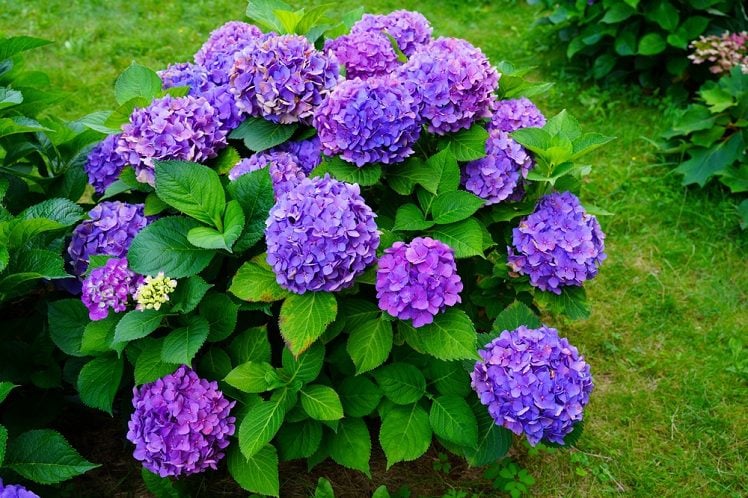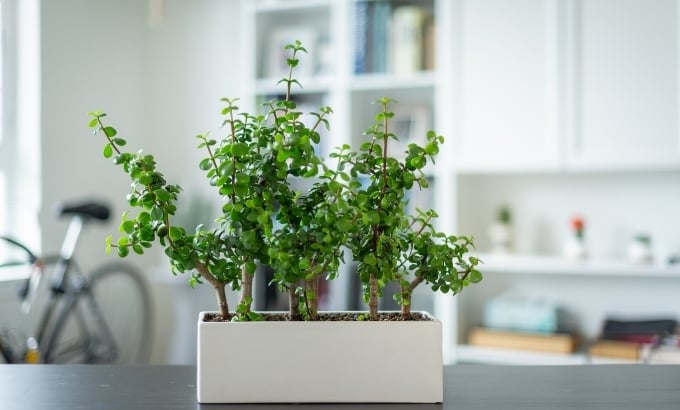Besides evergreen shrubs, in Minnesota there are also perennial woody that often belong to native shrubs for sun or shrubs for shade. The shrub, in residential areas, usually is used for the ground cover or to add some privacy to the yard since it looks like a small fence. So you can have a natural fence without building the real fence. Interesting, right?
Most of the wild shrubs usually are low maintenance because they can grow easily in wild areas. Sadly, some Minnesota native shrubs are considered as the species threatened due to their habitats being used for humans as recreational places. Find out the shrubs in Minnesota here!
Table of Contents
- 1. Ninebark (Physocarpus)
- 2. Hydrangea (hortensia)
- 3. Wild plum (Prunus americana)
- 4. Witch Hazel (Hamamelis)
- 5. Honeysuckle bush (Lonicera maackii)
- 6. Black Chokeberry (Aronia melanocarpa)
- 7. Squashberry (Viburnum edule)
- 8. Periwinkle (Vinca minor)
- 9. Swamp Holly (Ilex verticillata)
- 10. American Bittersweet (Celastrus scandens)
- 11. Beach Heather (Hudsonia tomentosa)
- FAQ (Frequently Asked Questions)
1. Ninebark (Physocarpus)
Guess it is hard to not know Ninebark as the shrub. It is common too to grow Ninebark in the yard as the ground cover. In Minnesota, you can see this perennial woody around cliffs, shores, and stream banks. The flower of Ninebark is very pretty with 5 round petals and white color or sometimes pink.


This plant likes to grow under rocky or sandy soil. If you have the soil that is ideal for Ninebark, you can have it. The blooming time for this shrub is in early summer. So, you can enjoy the flower throughout summer.
2. Hydrangea (hortensia)


It is also a well known and low maintenance shrub that you can find in Minnesota. This shrub is very adaptable and tolerant to the new environment. If you plan to grow this one, please prepare for the moist soil and full sun or partial shade locations.
Then you can let Hydrangea grow well in your yard. Hydrangea is hardy too. So no need to worry if you think that you can watch the plant every day.
3. Wild plum (Prunus americana)
At a glance, you will see that the flower of Wild Plum is a bit similar to Ninebark’s flower. The flowers also have 5 white petals too with white color. But, this shrub has fruits that look like plums. Hence the name. The fruit’s size is around 1 inch diameter, so it is not that big, perhaps like grapes.




Part shade or full sun locations are the best and favorite areas for Wild Plum to grow. Its beautiful flowers will bloom in May. So, it can be used as the sign that Spring is ready to go.
4. Witch Hazel (Hamamelis)
This perennial wood, of course, famous due to this shrub, is often used in some beauty products. Belongs to the flower clusters, each cluster usually contains 1 to 4 stalkless flowers. During fall, this shrub will bloom its flowers and you can find it in forest edges or wooded slopes because this plant likes part shade or shade locations.




Although this plant belongs to shrubs, the height is higher than usual shrubs since it can reach 6 – 20 feet compared to other shrubs that commonly its height is only up to 12 feet. The fruit of witch hazel is capsule shaped, not a berry or cherry shape.
Unfortunately, this beautiful shrub is considered as a threatened species because there are only 4 species that are known and only 8 that can be discovered. It becomes rare since the original habitat of this plant is often used for logging.
5. Honeysuckle bush (Lonicera maackii)
For the flower clusters enthusiast, you have to see this Honeysuckle bush. The shrub that is native to Minnesota. Although the shrub comes with flower clusters, it is pretty different from another flower cluster. You can see clearly that the shape of the flower has flower tubes.




As for the colors, the flowers that initially pale yellow or greenish yellow and turn into orange to red due to aging. The shape looks like lily yet in a mini size. Honeysuckle bush can be found easily in the woods, woodland edges or the area where there is sandy or rocky soil. This shrub also likes part shade spots or shady locations.Guess you can find it easily in Minnesota.
6. Black Chokeberry (Aronia melanocarpa)
Beautiful white flowers of the shrubs, and there are fruits that look like blackberry as well since the color is bluish blackberry makes this Minnesota native shrub become attractive to see. You can see it in central and north eastern forests in Minnesota. Black Chokeberry likes part shade or sun locations, the soil that makes this shrub happy to grow is moist to wet.


So, when you are going to the central or north eastern forest, you can find it along swamps, bogs, or open shrubby wetland. Summer is the best time for the flower to bloom. Although the fruit looks like cherry, the taste is bitter, so it is not recommended to taste it while you see it.
7. Squashberry (Viburnum edule)
This perennial woody belongs to flowering shrubs because it has pure white flowers. Of course the flowers are tiny yet too cute to miss. You can find one of these Minnesota shrubs around riverbank, rocky or gravelly soil, lakeshores or cliffs. This plant can thrive under part shade sun. The leaves are simple with bright green color.


The height of this shrub is no higher than the knee, yet it still produces the berry. Among other berries that is native to Minnesota, this one is the least that people know. You can have it too in your yard if you can prepare the environment that is similar to the riverbanks or lakeshores for growing Squashberry. So, people will know more about this shrub.
8. Periwinkle (Vinca minor)
This shrub is probably well-known not only in Minnesota but around The US. You may know it as Creeping Myrtle. Although this shrub is considered an invasive plant, people still love this one. Purple flowers, leathery leaves and the small size of shrubs makes people tend to choose this one as their ground cover in the yard.


This fast growing perennial loves moist to dry soil with part shade or shady spots. It is not that hard to grow Periwinkle since it can grow wildly too. So, to have it as your ground cover, this shrub can answer your needs.
9. Swamp Holly (Ilex verticillata)
You may not know this native shrub of Minnesota since it is uncommon for most people. This perennial woody loves wet or sandy soil, therefore you can find it easily along the swamps or shores. There are male and female flowers that usually were born from separate plants, while sometimes one plant can produce both flowers too.


Swamp Holly has another name as well, you may call it Catberry. Not only flowers, this shrub also produces bright red berries too. Most people often find it difficult to distinguish this native shrub from Winterberry, but the leaves of Winterberry are larger and the flowers come in clusters. So it is easy to differentiate between Swamp Holly and Winterberry.
10. American Bittersweet (Celastrus scandens)
The fruit of this perennial looks like an orange in tiny size. You can see the flowers in male and female categories and the shape and look are a bit different. Male flower has yellow tips while the female flower has a lobed stigma at the top. Also the petals of female flowers are shorter than the male one, although the color is similar. This shrub likes shade and sun.




You can find this Minnesota native perennial around the woodland edges, fields, and prairies. To see the flowers bloom you can wait during early summer. Furthermore, this shrub is similar to Oriental Bittersweet that belongs to invasive shrubs. And due to the similarity between two shrubs, people often sell Oriental Bittersweet and claim it as American Bittersweet.
11. Beach Heather (Hudsonia tomentosa)
Yes, according to its name, this one is often found in sandy beaches. This perennial woody produces stunning yellow flowers that are quite different from another flowering shrub. The texture of the flower is very pretty. Also, this Minnesota native shrub loves sun but sadly, according to DNR, the habitat of Beach Heather is rare nowadays and damaged due to building the recreational place that often used the area of dunes to do their hobby.




Therefore, the habitat of this shrub in Minnesota is now under care of DNR because in 2013, Beach Heather was considered a threatened species. This is such sad news that the native shrub that has beautiful flowers and produces the fruit as well has to lose its own habitat due to the people that express their hobby without considering taking care of the environment as well.
Latest Post:
- The Touch-Me-Not Plant: Shy on the Outside, Powerful on the Inside
- Who Knew Crushed Eggshells Could Guard Your Plants?
- My Secret DIY Weed Spray That Actually Works—No Harsh Chemicals Needed!
- Who Needs Sleeping Pills When You Have Jasmine? This Fragrant Beauty Calms Your Nerves!
- Tired of Overpriced Blueberries? Grow Your Own Endless Supply with This Simple Method!
FAQ (Frequently Asked Questions)
What are low maintenance shrubs in Minnesota?
Black chokecherry, ninebark, and hydrangea can be your best options as the low maintenance shrubs in Minnesota. Moreover, you can plant it easily in your yard for the beautiful flowers that can bloom during summer or fall. It is very suitable for those who want to plant and do not have to maintain it weekly.
What makes good shrubs in Minnesota?
The color of flowers and the shape of foliage for the evergreen shrubs will make a good shrub in Minnesota. You can place the shrub as the ground cover, privacy screen or just to fill your yard and make it green and fresh. It is all up to you!
What is the fastest growing shrub in Minnesota?
The evergreen shrub which is the fastest growing shrub in Minnesota is Juniperus Skyrocket. This shrub can reach up to 15 feet tall. The foliage shape is like a needle with bluish green color.
Do boxwoods grow in MN?
Yes. Boxwoods can grow in Minnesota. Moreover, this one is very hardy and one and only deciduous plant that has no issues about its color during winter. Yes, the foliage will remain green. So, you can find something green if you plant this evergreen shrub for your yard.
What shrubs grow best on the west side of a house in Minnesota?
Flowering shrubs will grow best on the west side of a house in Minnesota. So, you can start by choosing your favorite flowering shrubs such as ninebark, periwinkle and many more. Choose based on the soil you can prepare to grow them.








